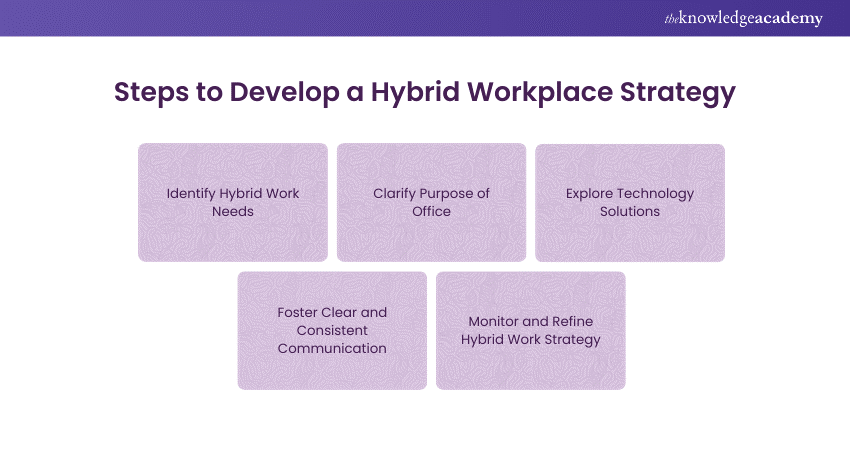We may not have the course you’re looking for. If you enquire or give us a call on +420 210012971 and speak to our training experts, we may still be able to help with your training requirements.
Training Outcomes Within Your Budget!
We ensure quality, budget-alignment, and timely delivery by our expert instructors.

Imagine blending the comfort of your home with the buzz of an office to harness a new rhythm of flexibility for the workforce! This best-of-both-worlds approach is made possible by the hybrid workplace model, which combines remote and on-site work to create a dynamic work environment. This approach empowers employees to work in their preferred settings and showcase greater productivity.
But how do you set up this framework for your own business? This blog has the answer, outlining the best elements, biggest benefits and the ideal way to craft the perfect Hybrid Workplace Strategy. So read on and learn how to energise your team and ignite success like never before!
Table of Contents
1) What is a Hybrid Workplace Strategy?
2) Hybrid Workplace Models
3) Steps to Develop a Hybrid Workplace Strategy
4) Elements of Hybrid Workplace Strategy
5) Advantages of a Hybrid Workplace
6) Disadvantages of Hybrid Models
7) Conclusion
What is a Hybrid Workplace Strategy?
A Hybrid Workplace Strategy is a plan that tailors the working environment to employees’ preferences and work habits, both remotely and in the office. It creates an improved workplace experience that empowers employees to be at their best while fulfilling the organisation’s overarching business objectives. When done right, a Hybrid Workplace Strategy enables the organisation to strike the perfect balance between what employees seek and what leadership wants.
Hybrid Workplace Models
While all hybrid workplaces have in-person and virtual workforces, there are different ways to structure them. For example, you may seek greater control over how the space gets used to optimise utilisation or maximum flexibility to enhance employee satisfaction. Most businesses fall between a rigidly structured or flexible model, balancing the facility’s capabilities, leadership requirements, and employees’ preferences.
a) Structured
In a structured hybrid workplace, you get to decide who works remotely and when. The virtual employees may have a schedule for when they’re remote and when they should be on campus or may have specific employees who are strictly remote and others who are always on campus.
This is more common in organisations where some roles can’t be performed remotely or the workforce is more distributed. Increasingly, the structured hybrid model is being implemented as a middle ground between employees who seek total autonomy and employers who wish for in-person workforces.
b) Flexible
Employees gain more autonomy over their work schedule and environment in a flexible hybrid workplace. They may have a limited number of days to work remotely every week or month, or they could have full freedom to decide which days they work from campus.
Depending on the type of work, employees may also be able to set their hours. This level of flexibility requires a more significant percentage of reservable workspaces, as you'll have to expect more variance in regard to where and how people want to work each day.
Steps to Develop a Hybrid Workplace Strategy
Every company’s Hybrid Workplace Strategy will differ depending on the industry, size, location, and organisational culture. However, all hybrid workplace strategies involve the following steps, which aim to offer flexibility to employees and employers alike.

1) Identify Your Hybrid Work Needs
The number of days the employees are required in the office will influence the necessary office space and technology infrastructure requirements. You must figure out this aspect of your workspace strategy before you take the next step.
You can understand employee preferences by administering a survey with the following questions:
a) How often would you like to come to the office?
b) Are you more comfortable with a structured schedule or a flexible schedule?
c) Do you feel more productive working in the office or at home?
d) Which tasks do you perform more effectively in the office?
e) Do you have sufficient at-home office space?
f) Are you in need of any at-home equipment?
Based on the responses and the business objectives, a hybrid work schedule can be set that balances everyone’s needs or enables each employee to customise their schedule instead.
2) Clarify the Purpose of Your Office
Before the advent of remote work, office spaces had a straightforward purpose: to provide employees with a place to come together and conduct business. But now that so much work can be performed remotely, this defined purpose is no longer sufficient.
More precise office purposes include offering your employees a space to:
a) Enable collaboration on projects.
b) Meet weekly to discuss important topics.
c) Conduct meetings with clients.
d) Be more productive if their home is too distracting.
An office space is more likely to be used in multiple ways. By clarifying its primary functions, the office configuration can be designed accordingly, and investment can be done in the right office resources.
Looking for motivational strategies to inspire and engage your employees? Sign up for our Employee Engagement Training now!
3) Explore Technology Solutions
Once the office space is arranged, it’s time to select the hybrid work technology. You’ll likely need web-based document management and video conferencing software. Depending on operations, you may also need to invest in additional tools.
Employees can offer insight into what solutions would help them do their best work from home and compare various providers. Once the chosen suite of tech solutions has been finalised, you can start implementing them and training employees on how to use each tool.
4) Foster Clear and Consistent Communication
Without clear policies, the hybrid work model can damage your team’s communication. Establishing clear communication expectations within the HR policies can prevent this. For example, remote employees can be required to respond to every email within 24 hours or schedule company-wide conference calls every week to give everyone an opportunity to connect.
5) Monitor and Refine Your Hybrid Work Strategy
Managing a hybrid team and implementing a successful strategy is a time-consuming endeavour. What works during one quarter may not yield similar results in the next. So, monitoring the performance metrics and regularly requesting employee feedback is vital. This information lets you fine-tune the Hybrid Workplace Strategy as needed.

Elements of Hybrid Workplace Strategy
A successful Hybrid Workplace Strategy needs a combination of policies, technology, and a culture that supports remote and in-office work. The hybrid work model has created different needs and resulted in the following necessary elements:
1) Advanced Workplace Technology
A strong technology infrastructure, including reliable internet connectivity, video conferencing software, and collaboration tools, is essential to support a hybrid workplace. It's vital that you enable how people connect with each other and the office, no matter how they choose to work. Desk booking tools are crucial for hybrid work, as is the capacity to book meeting spaces through room scheduling software.
2) Clear Workplace Strategy
Clear policies that outline expectations, guidelines, and communication protocols are vital for successful hybrid workplaces. These policies must be flexible enough to accommodate the requirements of both in-office and remote workers. Additionally, effective communication, including regular feedback sessions, check-ins, and transparent communication channels, is critical for a hybrid workplace to function smoothly.
3) Hybrid Scheduling Management
This is an essential capability for hybrid work because employees want to collaborate in the office and see their colleagues. It would help if you empowered them with tools that support scheduling coordination. Nothing dampens the employee experience quicker than commuting into an empty office just to sit on Zoom calls. After all, you can do that at home. So, remember, people come to the office to see and work with others.
4) Desk and Office Space Configuration
Due to staggered and uncertain in-office schedules, the configuration will differ with hybrid work compared to the traditional, pre-pandemic office structure. The days of the designated office and fixed desk are over, as organisations experiment with various approaches, including hoteling and hot desking.
5) Employee Feedback and Training Plans
With the 'one employee, one desk' workplace framework long gone, you’ll need to ask the employees what they want and expect from the office. Collecting employee data is the right way to develop and optimise any Hybrid Workplace Strategy. It’s an essential conversation that can lead to higher employee satisfaction.
Additionally, adequate training and development opportunities are needed to ensure employees are equipped to work effectively in a hybrid workplace. This can include training on time management, virtual collaboration, and communication skills.
6) Well-defined Performance Metrics
Clear performance metrics are essential for measuring the success of a Hybrid Workplace Strategy. These metrics must be based on outcomes rather than time spent online or in the office. To measure the success of your hybrid work strategy, you can look into office utilisation, employee satisfaction, engagement in a hybrid working environment, meeting participation, etc.
Want to gain deeper insight into the principles of employee engagement and motivation? Sign up for our Employee Relations Training now!
Advantages of a Hybrid Workplace
Hybrid workplaces have several key advantages that can benefit your business and employees. While some of these benefits come from simply having remote employees, by continuing to utilise physical office space, a hybrid model can retain your business flexible in many other ways.

1) Boost Employee Satisfaction and Well-being
It's easier to ensure a healthy work-life balance when employees can control how and when they work. Suppose the WFH policy doesn’t include a set work schedule for each day. In that case, employees can plan their workday around appointments, social activities, childcare, and other commitments that are more challenging to juggle with a fixed schedule.
Hybrid models can elevate employee satisfaction and well-being by making both environments an option at least part of the time.
2) Enhance Productivity
Although some data suggests employees are often more productive when working from home and other locations than in the office, this certainly isn’t true for every employee or workplace. It comes down to the individual and their circumstances, their role in the industry, and how the model is implemented. But when employees are free to choose when and how they work best, that’s when they deliver their best work.
3) Decrease Real Estate Costs
If a set percentage of the workforce is virtual, dedicated space is not dedicated for them all, which means you don’t need as much space as you would with a fully in-person workforce. A hybrid model allows businesses to save ample space so that they can downsize their offices, sublet floors, or reconfigure the space to significantly reduce occupancy costs.
4) Expand Access to a Broader Talent Pool
In a traditional workplace, the further your business is from large talent pools, the harder it is to hire needed employees. Embracing remote work means that a business won’t be limited to local talent or people willing to relocate when you need to fill positions.
This is valuable whether your locations are in cities with a high cost of living or more remote areas. Additionally, it helps if you’re in competitive regions where companies keep poaching your best prospects.
5) Encourage Creative Use of Office Space
In-person employees need workstations, and shifting some of them to remote work will require fewer workstations. So, this space can be allocated for different purposes. A hybrid workplace makes it easier to reconfigure space and pivot plans to accommodate spontaneous needs, changing goals, and increasing demand for specific types of spaces, including conference rooms and 'neighbourhoods' where teams can collaborate.

Disadvantages of Hybrid Models
While hybrid work boasts numerous benefits over fully remote and in-office models, managing in-person and virtual workforces can also create new workplace challenges. While technology and best practices can remedy some of these challenges, others are simply the price you pay for using a hybrid model.
1) Potential Bias Toward in-office Employees
Every conversation in an office can sway who receives better opportunities and even promotions, not based on merits but on proximity to people in leadership roles. Add to it the fact that marginalised groups are more inclined towards remote work to avoid microaggressions and discrimination, and the bias towards in-person workers can grow more problematic.
2) Difficulty in Coordinating Office Schedules
The value of face-to-face interactions and in-person collaboration has been one of the arguments for employers to encourage workers to return to the office. However, without careful coordination, hybrid workers can easily find themselves commuting to an empty office. The office may also be empty because, on that day, the people they needed to collaborate with happened to be working remotely.
3) Challenges in Tracking Space Utilisation
Managing a workplace with in-person and virtual employees adds a new dimension to the challenge of space utilisation because the demand for space fluctuates more. This is especially true if the hybrid workplace provides maximum flexibility to employees, as it’s more difficult to predict when employees will be in the office. This can result in businesses having far too little or too much space set aside for hoteling.
Conclusion
The key to a winning Hybrid Workplace Strategy is striking the right balance between remote and on-site work. It blends the best of both worlds to create a flexible work environment, resulting in enhanced customer satisfaction and amplified productivity. As this blog outlines, the future of work is hybrid, and understanding how to craft a Hybrid Workplace Strategy is essential for any modern business owner.
Learn about the essential safety practices for confined workspaces in our comprehensive Confined Space Training – Sign up now!
Frequently Asked Questions

The 5 C's of hybrid work are communication, coordination, connection, creativity, and culture.

A hybrid role involves assigning two or more jobs to a single person. The position can be exclusive to a department, but it often includes responsibilities that span departments like marketing, IT, and customer service.

The Knowledge Academy takes global learning to new heights, offering over 30,000 online courses across 490+ locations in 220 countries. This expansive reach ensures accessibility and convenience for learners worldwide.
Alongside our diverse Online Course Catalogue, encompassing 19 major categories, we go the extra mile by providing a plethora of free educational Online Resources like News updates, Blogs, videos, webinars, and interview questions. Tailoring learning experiences further, professionals can maximise value with customisable Course Bundles of TKA.

The Knowledge Academy’s Knowledge Pass, a prepaid voucher, adds another layer of flexibility, allowing course bookings over a 12-month period. Join us on a journey where education knows no bounds.

The Knowledge Academy offers various Employee Engagement Courses, including the Effective Employee Engagement Course and the Employee Training and Development Course. These courses cater to different skill levels, providing comprehensive insights into What is Employee Engagement.
Our HR Blogs cover a range of topics related to workplace, offering valuable resources, best practices, and industry insights. If you are looking to advance your workplace culture, The Knowledge Academy's diverse courses and informative blogs have got you covered.
Upcoming HR Resources – Learn about Human Resources Batches & Dates
Date
 Employee Engagement Training
Employee Engagement Training
Fri 6th Dec 2024
Fri 24th Jan 2025
Fri 28th Mar 2025
Fri 23rd May 2025
Fri 25th Jul 2025
Fri 26th Sep 2025
Fri 28th Nov 2025
 Halloween sale! Upto 40% off - 95 Vouchers Left
Halloween sale! Upto 40% off - 95 Vouchers Left







 Top Rated Course
Top Rated Course



 If you wish to make any changes to your course, please
If you wish to make any changes to your course, please


